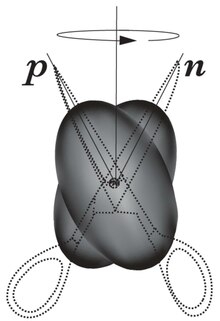Scissors fashion
The scissors fashion ( English scissors mode ) is a vibration excitation , the deformed with heavy nuclei is observed.
description
Atomic nuclei whose proton and neutron numbers are far from magic numbers - for example, nuclei of the rare earth elements , are often deformed, i.e. That is, they already deviate from the spherical shape in their basic state . Most of them can be described as ellipsoids of revolution.
The scissors mode is a magnetic excitation of such a nucleus, namely a dipole excitation, because the parity of the excited state corresponds to that of the basic state when one angular momentum unit is transferred.
The scissors mode can be illustrated geometrically: the ellipsoid of revolution formed by all protons executes a torsional oscillation against the neutron ellipsoid , similar to the two parts of a pair of scissors (see Fig.). Thus the scissors modes can be used as magnetic counterpart of the electric dipole - giant resonance are understood, which is clearly a linear vibration of protons to neutrons.
The scissors mode is a collective stimulus; This means that it cannot be explained as an effect of a single particle, but rather many protons and neutrons contribute to this excitation.
History and state of research
The scissors fashion was - according to the picture mentioned above - predicted for the first time in a semi-classic two-rotor model , then also in the context of the Interacting Boson Model . The first experimental evidence was obtained in 1983 by Achim Richter's research group at the DALINAC electron accelerator , the predecessor of today's S-DALINAC at the TU Darmstadt , in inelastic electron scattering .
The state of research includes a.
- the investigation of the form factor of the excitation in electron scattering, which provides information about the processes in the nucleus during the excitation,
- the (unsuccessful) search for spin contributions in proton scattering, which makes it clear that it is a trajectory of protons and neutrons that lead to nuclear excitation,
- the detailed investigation of the scissors mode by excitation with gamma radiation , whereby many partial excitations were identified,
- the description of the experimental findings by numerous models that support the illustration presented above,
- the realization that the scissors mode can be viewed as a special case of a class of excited states with low excitation energy, in which protons and neutrons move in opposite directions ("mixed symmetric states").
An overview of the state of research was published in 2010 in the journal Reviews of Modern Physics .
Individual evidence
- ↑ N. Lo Iudice, F. Palumbo: New Isovector Collective Modes in Deformed Nuclei , Phys. Rev. Lett. 41: 1532 (1978). doi : 10.1103 / PhysRevLett.41.1532
- ^ F. Iachello: Electron scattering in the interacting boson model , Nucl. Phys. A 358, 89c (1981). doi : 10.1016 / 0375-9474 (81) 90308-0
- ↑ D. Bohle et al .: New magnetic dipole excitation mode studied in the heavy deformed nucleus 156 Gd by inelastic electron scattering , Phys. Lett. 137B, 27 (1984). doi : 10.1016 / 0370-2693 (84) 91099-2
- ^ K. Heyde et al .: Magnetic dipole excitations in nuclei: Elementary modes of nucleonic motion , Rev. Mod. Phys. 82: 2365 (2010). doi : 10.1103 / RevModPhys.82.2365
